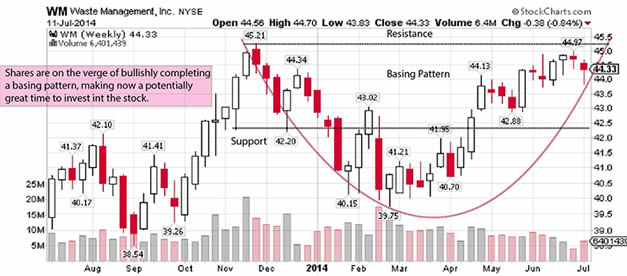This Company Turns Garbage Into Energy… And Could Pop 12% Soon
My 3-year-old son is obsessed with big, loud trucks — and garbage trucks are his absolute favorite.
#-ad_banner-#So you can imagine the excitement every Friday morning when the garbage truck stops in front of our house. At the first clang of the trash can, he sprints to the window. Intensely engaged, he curiously demands a step-by-step explanation of the entire garbage collection process.
His enthusiasm for garbage trucks sent me looking into investment-worthy waste stocks. While they’re not the most glamorous, they can make great investments.
Because clean cities are a necessity, their business is non-discretionary. As a result, many waste collection stocks show steady growth, despite economic turbulence.
Within in the waste industry, my favorite is North America’s largest garbage collection company, Waste Management (NYSE: WM). (As my colleague Marshall Hargrave recently noted, it’s also Bill Gates’ favorite stock in that industry.)
WM’s 3.4% forward annual dividend yield tops 90% of the stocks listed on the S&P 500 Index. Over the past 10 years, dividends have doubled, while payouts have increased 11 straight years.
Despite its name, the company’s business isn’t limited to trash. It’s also a top green energy producer. In fact, Waste Management generated more green energy than the whole U.S. solar industry last year.
How? Put simply, its gas-to-energy and waste-to-energy facilities turn decomposing organic matter into methane gas and thermal energy.
Waste Management then uses this natural gas to power its garbage trucks. About 15% of Waste Management’s fleet is natural gas-powered. Within the next six years, the company plans to convert 80% of its trucks to natural gas. Waste Management also owns more than 50 natural gas fueling stations, 20 of which are open to the public.
Turning trash into green energy is an increasingly important growth driver. In the first quarter, the company’s waste-to-energy division generated $230 million, a 12% increase from the year-earlier period. Although 80% of Waste Management’s revenue still comes from garbage collection, this figure will likely shift over time, providing a truly natural income source.
International expansion is also an important growth factor. Currently dominating North America, Waste Management plans to increase its presence in China, the country with the world’s largest population. By 2020, Waste Management estimates it will handle more than 20 million tons of Chinese waste, 67% more than in 2012. This development could help sustain future revenue growth.
That’s positive news for Waste Management because even a surefire business like trash faces challenges. As consumers become more environmentally conscious, they’re generating less waste for disposal. According to the Environmental Protection Agency, in 1980, 89% of all waste produced went into a landfill. With more emphasis on composting and recycling, this number dropped to 54% by 2012.
However, due to lower commodity prices paid for recycled goods, Waste Management’s recycling operations are also suffering. Recycling accounts for about 10% of the company’s revenue.
To make up for these losses, Waste Management has increased its garbage collection and disposal prices. In the most recent quarter, pricing for these core operations increased 4.2%. With the price hike, the company expects 2014 revenue will increase 2.2%, to $14.3 billion, despite an anticipated 1% drop in waste volume.
Management is also clamping down on operating costs. In the most recent quarter, selling general and administrative (SG&A) expenses dropped 4% from the year-ago period. By streamlining back-office jobs, reducing operational costs, and optimizing collection routes, the company expects to further reduce SG&A costs in 2014.
Through reduced capital expenses, management projects 2014 earnings will be in the range of $2.30 to $2.35 per share, at least a 7% gain from $2.15 per share in 2013.
From a technical perspective, the stock looks strong. Shares are on the verge of breaking out of a multi-month basing pattern. This pattern, which looks like a large U-shape, is characterized by the peak last November, followed by the February low and the stock’s climb back to the high near $45.

If shares can move past that high, they could soar with no further technical barriers in the way.
Risks to Consider: Decreased waste volumes and lower commodity prices for recycled materials have negatively impacted Waste Management’s revenue growth. For the company to stay an attractive long-term investment, it will need to continue developing innovative, money-making solutions in its gas-to-energy and waste-to-energy divisions.
Action to Take –> To maximize potential reward, I suggest buying shares if they hit or go above the $45 peak, for potential 12.1% returns. To minimize potential risk, I suggest selling the stock if it falls below $42.20.
This article was originally published at ProfitableTrading.com:
It’s Almost Time To Buy This High-Yield Blue Chip
